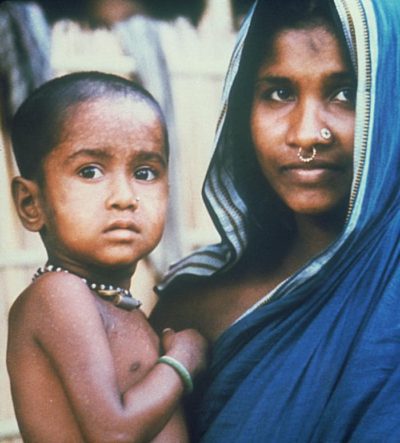Bilkisunnessa is 11 years old – but growing up in the pit bottom of extreme poverty, chronically malnourished, she looked like a 8 years old.
She made this trip on (bare)foot along the river edge, across rice paddy, cutting through people’s backyards to the local rural health / immunization center. Most of the time running than walking. From her previous vaccination visits with her mother – she knew the way very well.
She had a secret with her. She wouldn’t tell that to any grown up, not even her parents. She, with the wisdom beyond her ages, rightly understood it was a very important matter and local healthcare workers need to know that.

Bilkisunessa is the typical tomboy. Whoever saw Ray movies ‘Pather Panchali’ would identify her with Durga, sister of Opu. She would run around the village, home to home, tree to tree. Being a child herself, she has unfettered access indoors, backyards and front yards. And this is how she came across and overheard the sickness of 3-year-old Rahima Banu.
It was Early November 1975. Apart from ongoing political turmoil of that time, Bangladesh was the last country in Asia which hasn’t yet eradicated Small Pox. WHO is giving a final last push to eradicate smallpox from this planet. In Bangladesh there was 1000 epidemiologists, 12000 health workers, 13000 ancillary supporting stuff including 65 foreign experts working towards one goal, eradication of virus, smallpox! After 3 year 11 months of frantic effort, the Bangladesh team finally succeeded. What they thought was the last case of Smallpox in Asia, was found and contained in Chittagong, a southern-eastern district of Bangladesh. Six weeks went by without any further case. New York Times made a first page report on the last case of smallpox. Congratulatory notes from WHO, CDC started pouring in Dhaka (Capital city of Bangladesh) Smallpox HQ.
Bilkisunnessa arrived at the local health center in the remote small island outskirts of southern Bangladeshi district of Bhola. At that time because of public fear of smallpox, if someone in community was found to have smallpox, local people would go and burn down that house and kick the peoples out of the village. Hence marginal people would hide any smallpox event. Bilkisunnessa feared that and hence maintained strict secrecy.

As the telegram of November 14 1975 suggesting report of a suspected smallpox (local office always had strict order not to approach the village/ patient without experts) reached dhaka (Capital City of Bangladesh) smallpox HQ, the stunned Dhaka team got to action instantly. Led by An American, a British and a French trio – Stan Forster, Daniel Tarantola, Jason Weisfeld – a fact finding team of 200 people immediately departed towards southernmost district of Bangladesh, Bhola. All passenger tickets were cancelled – the speedy Launch called ‘Rocket’ was reserved which will take the team to the first stop – Barisal district by an overnight River journey. By the time the team of 200 with dozens of land rovers, speedboats, motorbikes, onboard engines, bicycles, vaccines, medicine, food, fuel tank reached the last navigable port/ road – they still had mile long walk through narrow village alleys to Rahima Banu’s home.
Approaching a victim of this highly contagious disease requires to be done by experienced staff. Steve Schnurr and Daniel Tarantola entered the tiny tree lead made hut and found 3-year-old Rahima Banu under piles of torn rugs. Looking at her small exposed legs – both the smallpox experts right away knew it was the case of Variola Majora!
The house was locked down. An Army platoon locked down the 1.5-mile radius entire village. Vaccination started same night. Dhaka HQ was radioed that Variola Majora confirmed and reinforcement requested. New York Times reported, “Last Case of Smallpox detected – again”. Expert workers were flown in from India, Philippines, Thailand, Afghanistan. For the next 90 days, a WHO/ CDC team of a few thousand workers including a few dozen expatriate experts camped in that remote island outpost outskirts of southern Bhola district of Bangladesh. Every one of 19000 residents of that island outpost was accounted for.
Rahima Banu recovered. Her virus strain was collected and is still preserved in CDC BSL-4 lab in Atlanta, Georgia. It is labelled ‘Bangladesh strain’. Unofficially scientists and epidemiologists called it Rahima strain.
Rahima Banu was world’s last case of Variola Major, the scarier dangerous type of smallpox.
A couple of years later, the last case of Variola minor, the rare mild form of Smallpox was treated in Kenya.
WHO waited three more years and continued combing surveillance and on this day May 8 1980, formally announced eradication of Small Pox. Mankind’s first decisive victory against a deadly virus.
Earlier in 2020 the New York Times published a very informative diagram. On the X axis is the communicability of the virus and Y axis denoted fatality of the virus. So the higher up and the right most in the graph the virus is – the more transmissible and the more fatal the virus is. Some like Rabies, Ebola, bird flu is very fatal but poorly transmissible. Some like measles, mumps are highly contagious but not fatal. In the plot the virus came out as most transmissible and contagious was the smallpox virus.
Thought to be originated from African rodents, this virus periodically attacked and devastated human civilization for at least ten millennia. Egyptian pharaohs used to have smallpox, kingdom after kingdom in ancient and middle age Europe got ruined as smallpox killed all in the line of succession. When the Spanish brought it to Americas, it decimated the Inca and Aztec civilizations – paving the path of Easy European conquest.

A virus that ravaged our civilization for ten millennia had its last stand in little Rahima at the most poor most remote Bangladesh. But after ten millennia rule it was finally defeated.
A very organized international effort characterized by unprecedented collaboration between countries made it possible.
For her prompt public service action and wisdom beyond her ages, Bilkisuunnessa was rewarded Taka 150 ( $ 3.50). Rahima Banu defeated the virus, grew up, became a mother herself. She remains famous in public health world as the last case of smallpox in the world. Her images and story are all over in CDC archives and Smithsonian museum exhibitions!
Although she could beat the deadly smallpox virus and grew up in a smallpox free world, Rahima could never win over a more dangerous curse than smallpox, poverty! She now lives her life in abject poverty and fetches money to feed her children from public health students who go to see her.

